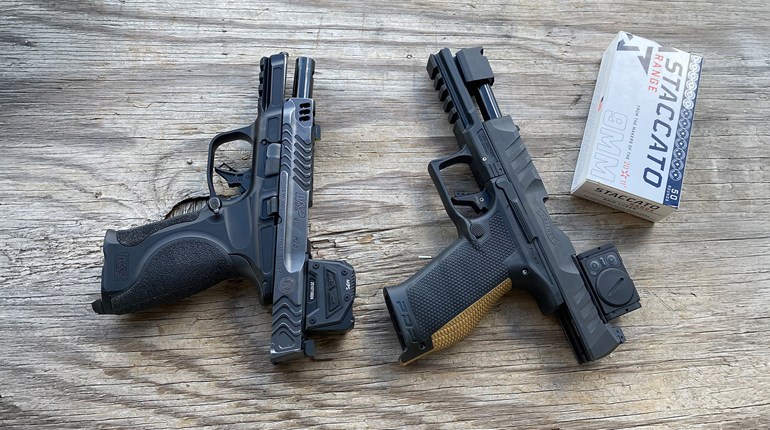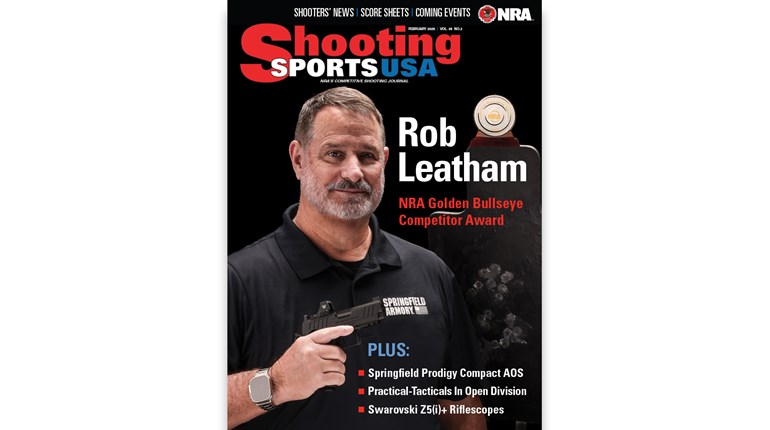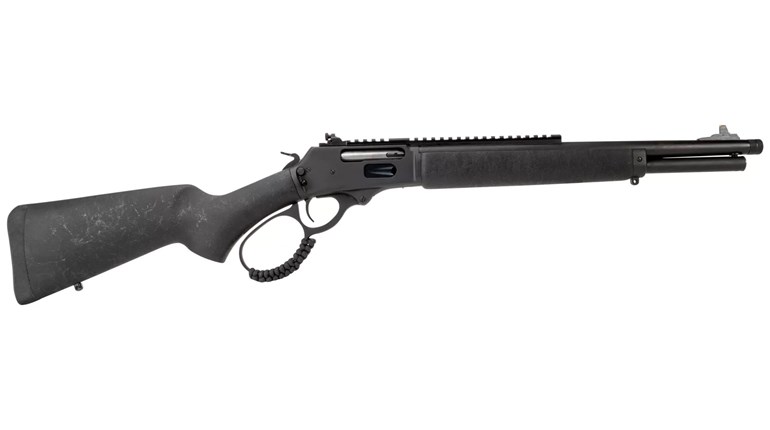
Not too long ago, guns with three-inch barrels and smaller frames were considered the ideal for carry; they were neither too big nor too small and handled just right. In fact, following the pattern, the FBI adopted the .357 Magnum Smith & Wesson Model 13 with a three-inch barrel and a round-butt as standard-issue for agents. Rossi’s new RP-63 revolver has the same hallmarks and currently exists as a reasonably priced option for those looking for a modern revolver in that “Goldilocks'” configuration.
Rossi RP-63 Overview
All major parts on the six-shot double-action Rossi RP-63 are manufactured from stainless steel with a satin finish, including the frame, barrel and cylinder. This pistol has an exposed hammer that also bears the firing pin directly–the way nearly all vintage double-action revolvers do. Hammer mounted firing pins have all but disappeared on modern revolvers. Like older wheelguns, the Rossi RP-63 has low profile fixed sights which are good for preventing snags when drawing from concealment.
 Rossi labels the RP-63’s frame size as “small”. For perspective, it’s smaller than an actual K-frame and larger than a true J-frame. Dimensionally, the RP-63’s frame is very close to its cousin, the frame on the Taurus 856. I think that calling it an “XL” sized J-frame is fair. The three-inch barrel is made from a single piece of stainless steel that also incorporates a full underlug and shroud for the ejector rod. The underlug is a nice feature that acts as a counterweight at the muzzle in order to minimize muzzle flip and adds some visual symmetry to this revolver. The standard RP-63 boot was adequate at filling the firing hand and providing space for middle, ring and pinky fingers. Building a proper two-handed grip was also easy enough.
Rossi labels the RP-63’s frame size as “small”. For perspective, it’s smaller than an actual K-frame and larger than a true J-frame. Dimensionally, the RP-63’s frame is very close to its cousin, the frame on the Taurus 856. I think that calling it an “XL” sized J-frame is fair. The three-inch barrel is made from a single piece of stainless steel that also incorporates a full underlug and shroud for the ejector rod. The underlug is a nice feature that acts as a counterweight at the muzzle in order to minimize muzzle flip and adds some visual symmetry to this revolver. The standard RP-63 boot was adequate at filling the firing hand and providing space for middle, ring and pinky fingers. Building a proper two-handed grip was also easy enough.
Although the Rossi RP-63 is best suited as a carry gun, it ships with a wide non-serrated “target-style” trigger by default, and after much dry-firing and live fire, I do think a regular “combat” trigger would suit it just fine. The combination of a wider trigger against a smaller frame can become somewhat uncomfortable after an extended session–dry or live. I found minor calluses on my finger after my range session. On the bright side, the Rossi RP-63 does have a decent action out of the box. The double-action trigger pull is quite smooth, and for a revolver at this price point, it surpassed my expectations. I’ve also noticed that the modern crop of Brazilian revolvers these days smoothes out quite nicely with use.
The Art Of Shooting A Revolver
On the firing line, I fired .357 Magnum 158-grain full-house JHPs and JSPs from Sierra and Federal’s American Eagle. Being that a .357 Magnum revolver can safely shoot .38 Spl. ammo, I also tried some .38 Spl. hollow points from Federal and Sierra. Lastly, I shot 50 rounds of my own general-purpose .38 Spl handloads loaded with a 158-grain LSWC bullet over 3.5 grains of HP-38 powder. My evaluation for the RP-63 saw nearly 200 rounds combined. Roughly 33 percent of all rounds fired were either of the full-house .357 Mag. loads, and I am happy to report that none of the Rossi’s screws loosened up when I was finished shooting. Even though the revolver was plenty hot and sooty after shooting all of these rounds, the action was not gritty or gummy and trigger pulls still felt smooth. Extraction of spent cases was not too problematic, besides the factory loaded Sierra magnum cases that were a smidge sticky and needed a stouter whack of the ejection rod. Although the Rossi RP-63 can handle those rounds (and quite accurately may I add), I would not recommend beginners shoot full power .357 Mag. ammunition through this gun, as it does take better grip technique and finesse to handle correctly. The noise, felt recoil and muzzle flip can also be more dramatic and new shooters run the risk of developing a flinch and perhaps losing control of the muzzle.
 Shooting fixed-sight revolvers with a double-action trigger pull is as much of an art as it is a science, and there are more subtleties that happen compared to shooting the typical modern semi-auto. For starters, the point of impact can and will vary somewhat between each shooter. Secondly, finding a load that shoots well in the revolver is paramount. In a sense, these fixed sight revolvers require a “patterning” of sorts similar to patterning shotshells through a shotgun or evaluating different cartridges in a rifle to see what groups the best. For example, besides my required groups from rest, I also shot two cylinders of each load double action and freestyle at a 6-inch circle at 10 yards. My groups were about 3 to 3 ½ inches and off to the left inside that circle, maybe not ideal for Bianchi Cup, but suitable for a defensive double action revolver with small sights. Shooting a “classic” revolver is more involved the way driving a manual transmission car is also more involved. I noticed that my groups as a whole were starting to tighten up as I got a better feel for the revolver. My body and brain were both consciously and subconsciously adjusting for better shooting.
Shooting fixed-sight revolvers with a double-action trigger pull is as much of an art as it is a science, and there are more subtleties that happen compared to shooting the typical modern semi-auto. For starters, the point of impact can and will vary somewhat between each shooter. Secondly, finding a load that shoots well in the revolver is paramount. In a sense, these fixed sight revolvers require a “patterning” of sorts similar to patterning shotshells through a shotgun or evaluating different cartridges in a rifle to see what groups the best. For example, besides my required groups from rest, I also shot two cylinders of each load double action and freestyle at a 6-inch circle at 10 yards. My groups were about 3 to 3 ½ inches and off to the left inside that circle, maybe not ideal for Bianchi Cup, but suitable for a defensive double action revolver with small sights. Shooting a “classic” revolver is more involved the way driving a manual transmission car is also more involved. I noticed that my groups as a whole were starting to tighten up as I got a better feel for the revolver. My body and brain were both consciously and subconsciously adjusting for better shooting.
From the small assortment of ammunition that I tried out, the Sierra 158-grain .357 Mag. JHP printed the tightest and closest groups to my point of aim. The downside is the burden of recoil and sound of a magnum round. Neither the .38 Spl. 125-grain Sierra or the 130-grain Federal HydraShok .38 Spl. +P were slouches either and between those, my Federal freestyle group was a smidge tighter. Although this revolver has snag-free fixed sights, I think the sights can use some improvement. The rear sight notch could be wider and deeper as it’s too shallow and narrow for my tastes. Expanding it would not only allow more light to creep in from either side which would make it easier to have a better sight picture, but a deeper rear notch deeper would also help slower .38 Special rounds print a little higher and closer to the point of aim at 10 yards. Out of the box, the revolver is regulated for faster (read: .357 Mag.) rounds. The front sight itself would be better off being of a high-contrast color as it was very easy to lose it while aiming at black targets. Mid-session, I switched to shooting white targets to better see my sights .
The Takeaway
For the price, the RP-63 isn’t a bad starting point for a classic 6-shot carry revolver that is basically legal to possess in all 50 states and has roughly the same footprint as a Glock 48. The pistol is solid and has a fairly smooth action out of the box. Shooting almost 200 rounds in one sitting including several “full-house” .357 Mag. loads yielded no issues for, not even a loose crane screw. For certain people revolvers still make sense to carry, and those who are new should take heed. Even just to keep and shoot for fun, this revolver is still affordable. Like I described above, fielding revolvers is also an art with a steeper learning curve. That said, few things feel as rewarding as being proficient with a revolver.
Rossi RP63 Revolver Specifications:
- Make: Amadeo Rossi SA
- Model: RP-63
- Action: Double Action
- Caliber: .38 Spl +P / .357 Mag.
- Frame Size: Small
- Barrel Length: 3 inches
- Frame/Cylinder/Barrel Material: Stainless steel
- Height: 5.20 inches
- Width: 1.46 inches
- Overall Length: 7.95 inches
- Sights: Fixed rear sight, removable fixed front sight
- Twist Rate: 1 in 16.5 RH Twist
- Safety: Hammer block
- Cylinder Capacity: 6
- Barrel Grooves: 6
- Weight: 27.30 ounces
- Finish: Satin stainless steel
- Country Of Origin: Brazil
- MSRP: $460.99
7yd Accuracy Report
|
Ammo: |
Min Group (inches) |
Avg Group: |
Max Group: |
|
Sierra .357 Mag. 158-grain JHP |
1.00 |
1.18 |
1.50
|
|
Sierra .38 Spl. 125-grain JHP |
1.00 |
1.20 |
1.50 |
|
Federal .38 Spl. +P 130-grain Personal Defense HydraShok Deep |
1.00 |
1.40 |
1.75 |




































